Performance Analysis of Mercedes-Benz
VerifiedAdded on 2020/10/23
|12
|3573
|298
AI Summary
The provided document is an academic assignment that analyzes the performance of Mercedes-Benz, a luxury vehicle provider, through various analytical models such as PESTLE analysis and competitive analysis. The assignment evaluates the company's strengths and weaknesses in different markets and highlights its effective marketing strategies and consumer services. It also explores the relationship between investments in lean practices and operational performance, and discusses the impact of social sustainability orientation and supply chain practices on operational performance.
Contribute Materials
Your contribution can guide someone’s learning journey. Share your
documents today.
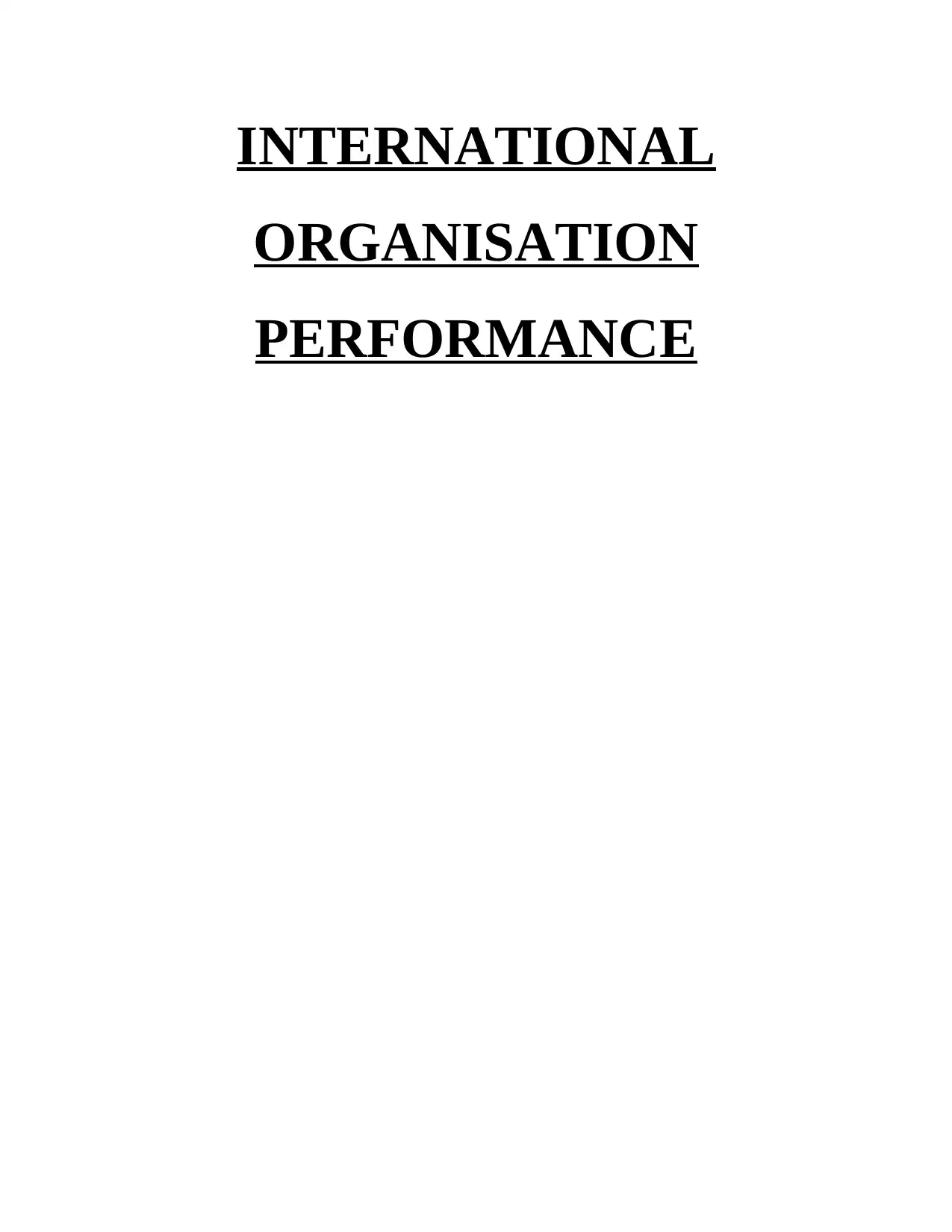
INTERNATIONAL
ORGANISATION
PERFORMANCE
ORGANISATION
PERFORMANCE
Secure Best Marks with AI Grader
Need help grading? Try our AI Grader for instant feedback on your assignments.
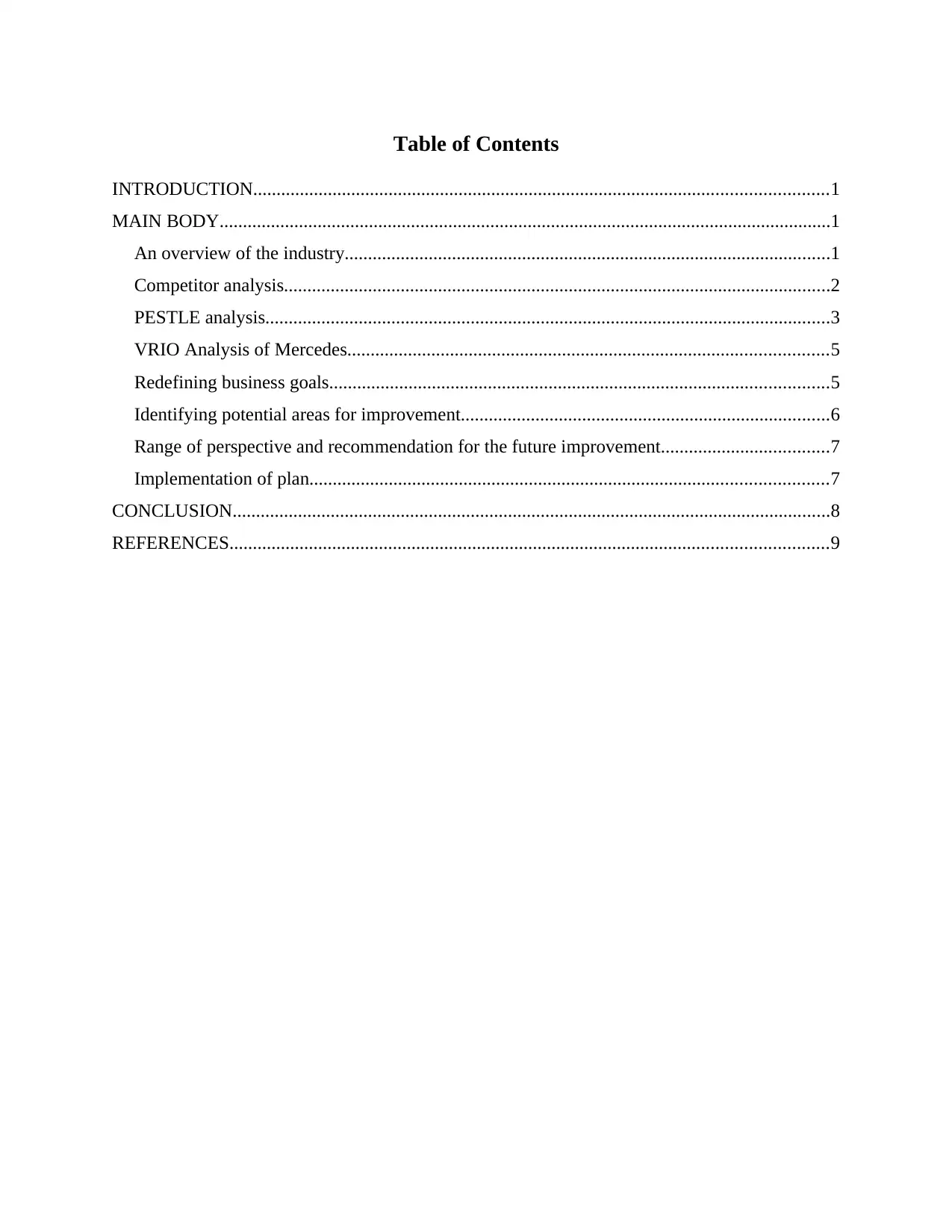
Table of Contents
INTRODUCTION...........................................................................................................................1
MAIN BODY...................................................................................................................................1
An overview of the industry........................................................................................................1
Competitor analysis.....................................................................................................................2
PESTLE analysis.........................................................................................................................3
VRIO Analysis of Mercedes.......................................................................................................5
Redefining business goals...........................................................................................................5
Identifying potential areas for improvement...............................................................................6
Range of perspective and recommendation for the future improvement....................................7
Implementation of plan...............................................................................................................7
CONCLUSION................................................................................................................................8
REFERENCES................................................................................................................................9
INTRODUCTION...........................................................................................................................1
MAIN BODY...................................................................................................................................1
An overview of the industry........................................................................................................1
Competitor analysis.....................................................................................................................2
PESTLE analysis.........................................................................................................................3
VRIO Analysis of Mercedes.......................................................................................................5
Redefining business goals...........................................................................................................5
Identifying potential areas for improvement...............................................................................6
Range of perspective and recommendation for the future improvement....................................7
Implementation of plan...............................................................................................................7
CONCLUSION................................................................................................................................8
REFERENCES................................................................................................................................9

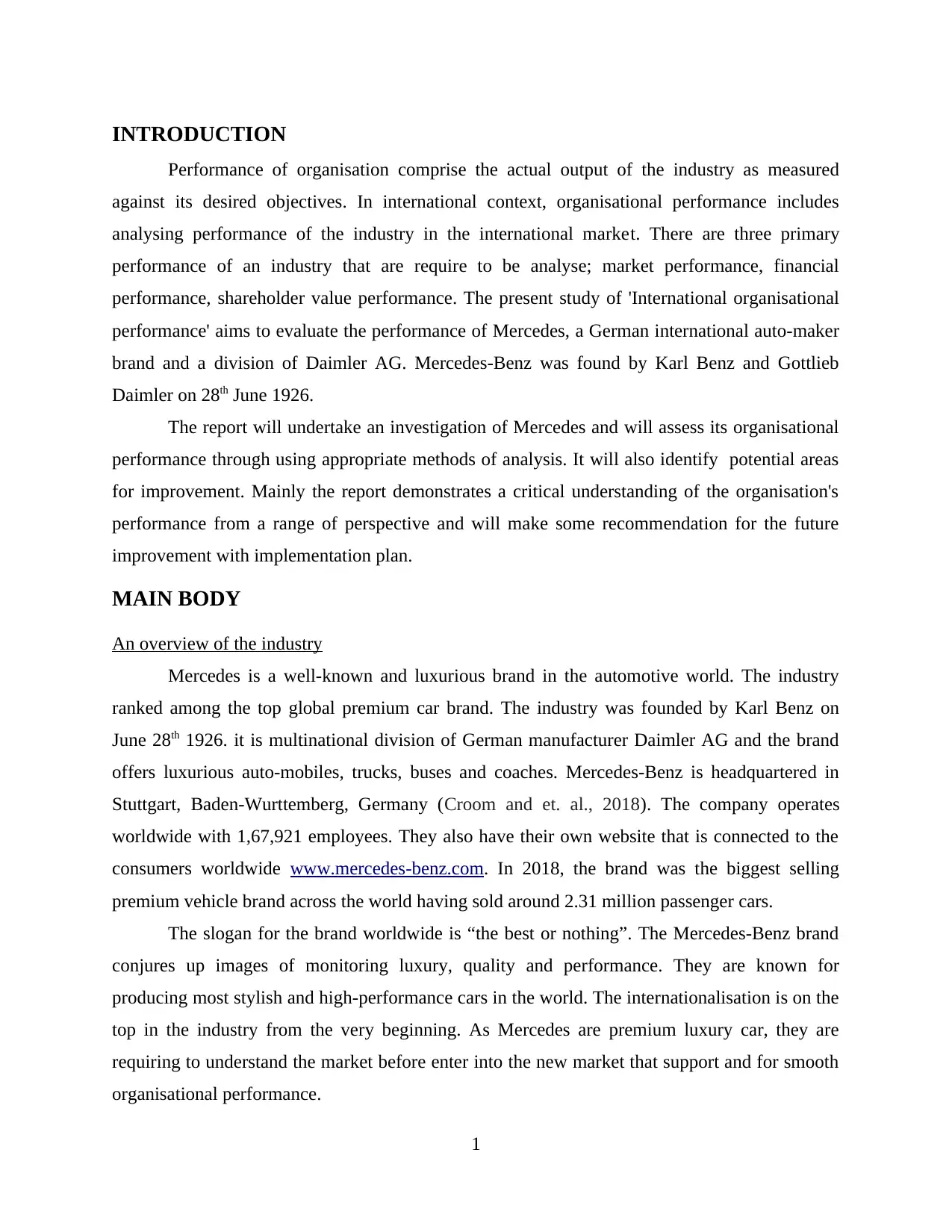
INTRODUCTION
Performance of organisation comprise the actual output of the industry as measured
against its desired objectives. In international context, organisational performance includes
analysing performance of the industry in the international market. There are three primary
performance of an industry that are require to be analyse; market performance, financial
performance, shareholder value performance. The present study of 'International organisational
performance' aims to evaluate the performance of Mercedes, a German international auto-maker
brand and a division of Daimler AG. Mercedes-Benz was found by Karl Benz and Gottlieb
Daimler on 28th June 1926.
The report will undertake an investigation of Mercedes and will assess its organisational
performance through using appropriate methods of analysis. It will also identify potential areas
for improvement. Mainly the report demonstrates a critical understanding of the organisation's
performance from a range of perspective and will make some recommendation for the future
improvement with implementation plan.
MAIN BODY
An overview of the industry
Mercedes is a well-known and luxurious brand in the automotive world. The industry
ranked among the top global premium car brand. The industry was founded by Karl Benz on
June 28th 1926. it is multinational division of German manufacturer Daimler AG and the brand
offers luxurious auto-mobiles, trucks, buses and coaches. Mercedes-Benz is headquartered in
Stuttgart, Baden-Wurttemberg, Germany (Croom and et. al., 2018). The company operates
worldwide with 1,67,921 employees. They also have their own website that is connected to the
consumers worldwide www.mercedes-benz.com. In 2018, the brand was the biggest selling
premium vehicle brand across the world having sold around 2.31 million passenger cars.
The slogan for the brand worldwide is “the best or nothing”. The Mercedes-Benz brand
conjures up images of monitoring luxury, quality and performance. They are known for
producing most stylish and high-performance cars in the world. The internationalisation is on the
top in the industry from the very beginning. As Mercedes are premium luxury car, they are
requiring to understand the market before enter into the new market that support and for smooth
organisational performance.
1
Performance of organisation comprise the actual output of the industry as measured
against its desired objectives. In international context, organisational performance includes
analysing performance of the industry in the international market. There are three primary
performance of an industry that are require to be analyse; market performance, financial
performance, shareholder value performance. The present study of 'International organisational
performance' aims to evaluate the performance of Mercedes, a German international auto-maker
brand and a division of Daimler AG. Mercedes-Benz was found by Karl Benz and Gottlieb
Daimler on 28th June 1926.
The report will undertake an investigation of Mercedes and will assess its organisational
performance through using appropriate methods of analysis. It will also identify potential areas
for improvement. Mainly the report demonstrates a critical understanding of the organisation's
performance from a range of perspective and will make some recommendation for the future
improvement with implementation plan.
MAIN BODY
An overview of the industry
Mercedes is a well-known and luxurious brand in the automotive world. The industry
ranked among the top global premium car brand. The industry was founded by Karl Benz on
June 28th 1926. it is multinational division of German manufacturer Daimler AG and the brand
offers luxurious auto-mobiles, trucks, buses and coaches. Mercedes-Benz is headquartered in
Stuttgart, Baden-Wurttemberg, Germany (Croom and et. al., 2018). The company operates
worldwide with 1,67,921 employees. They also have their own website that is connected to the
consumers worldwide www.mercedes-benz.com. In 2018, the brand was the biggest selling
premium vehicle brand across the world having sold around 2.31 million passenger cars.
The slogan for the brand worldwide is “the best or nothing”. The Mercedes-Benz brand
conjures up images of monitoring luxury, quality and performance. They are known for
producing most stylish and high-performance cars in the world. The internationalisation is on the
top in the industry from the very beginning. As Mercedes are premium luxury car, they are
requiring to understand the market before enter into the new market that support and for smooth
organisational performance.
1
Secure Best Marks with AI Grader
Need help grading? Try our AI Grader for instant feedback on your assignments.
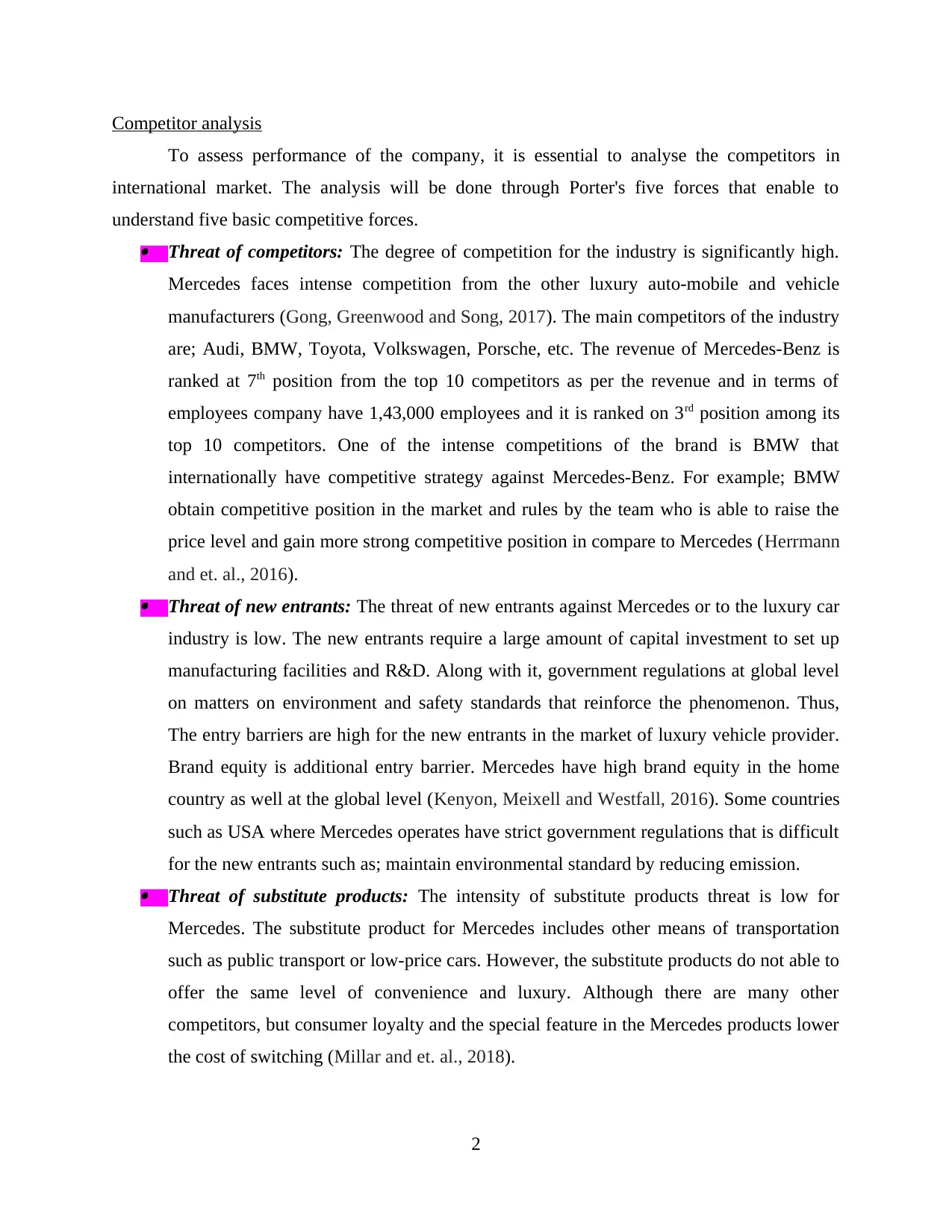
Competitor analysis
To assess performance of the company, it is essential to analyse the competitors in
international market. The analysis will be done through Porter's five forces that enable to
understand five basic competitive forces. Threat of competitors: The degree of competition for the industry is significantly high.
Mercedes faces intense competition from the other luxury auto-mobile and vehicle
manufacturers (Gong, Greenwood and Song, 2017). The main competitors of the industry
are; Audi, BMW, Toyota, Volkswagen, Porsche, etc. The revenue of Mercedes-Benz is
ranked at 7th position from the top 10 competitors as per the revenue and in terms of
employees company have 1,43,000 employees and it is ranked on 3rd position among its
top 10 competitors. One of the intense competitions of the brand is BMW that
internationally have competitive strategy against Mercedes-Benz. For example; BMW
obtain competitive position in the market and rules by the team who is able to raise the
price level and gain more strong competitive position in compare to Mercedes (Herrmann
and et. al., 2016). Threat of new entrants: The threat of new entrants against Mercedes or to the luxury car
industry is low. The new entrants require a large amount of capital investment to set up
manufacturing facilities and R&D. Along with it, government regulations at global level
on matters on environment and safety standards that reinforce the phenomenon. Thus,
The entry barriers are high for the new entrants in the market of luxury vehicle provider.
Brand equity is additional entry barrier. Mercedes have high brand equity in the home
country as well at the global level (Kenyon, Meixell and Westfall, 2016). Some countries
such as USA where Mercedes operates have strict government regulations that is difficult
for the new entrants such as; maintain environmental standard by reducing emission. Threat of substitute products: The intensity of substitute products threat is low for
Mercedes. The substitute product for Mercedes includes other means of transportation
such as public transport or low-price cars. However, the substitute products do not able to
offer the same level of convenience and luxury. Although there are many other
competitors, but consumer loyalty and the special feature in the Mercedes products lower
the cost of switching (Millar and et. al., 2018).
2
To assess performance of the company, it is essential to analyse the competitors in
international market. The analysis will be done through Porter's five forces that enable to
understand five basic competitive forces. Threat of competitors: The degree of competition for the industry is significantly high.
Mercedes faces intense competition from the other luxury auto-mobile and vehicle
manufacturers (Gong, Greenwood and Song, 2017). The main competitors of the industry
are; Audi, BMW, Toyota, Volkswagen, Porsche, etc. The revenue of Mercedes-Benz is
ranked at 7th position from the top 10 competitors as per the revenue and in terms of
employees company have 1,43,000 employees and it is ranked on 3rd position among its
top 10 competitors. One of the intense competitions of the brand is BMW that
internationally have competitive strategy against Mercedes-Benz. For example; BMW
obtain competitive position in the market and rules by the team who is able to raise the
price level and gain more strong competitive position in compare to Mercedes (Herrmann
and et. al., 2016). Threat of new entrants: The threat of new entrants against Mercedes or to the luxury car
industry is low. The new entrants require a large amount of capital investment to set up
manufacturing facilities and R&D. Along with it, government regulations at global level
on matters on environment and safety standards that reinforce the phenomenon. Thus,
The entry barriers are high for the new entrants in the market of luxury vehicle provider.
Brand equity is additional entry barrier. Mercedes have high brand equity in the home
country as well at the global level (Kenyon, Meixell and Westfall, 2016). Some countries
such as USA where Mercedes operates have strict government regulations that is difficult
for the new entrants such as; maintain environmental standard by reducing emission. Threat of substitute products: The intensity of substitute products threat is low for
Mercedes. The substitute product for Mercedes includes other means of transportation
such as public transport or low-price cars. However, the substitute products do not able to
offer the same level of convenience and luxury. Although there are many other
competitors, but consumer loyalty and the special feature in the Mercedes products lower
the cost of switching (Millar and et. al., 2018).
2

Bargaining power of supplier: The power of supplier in the luxury car segment are in no
position to bargain or to influence prices as they are attached with a renowned name
manufacturer. The supplier of Mercedes involves wood designers, maker of leather
products and car interior electronic device providers. The supplier of Mercedes is in
hundreds and being a supplier of this brand is an honour for them thus the supplier's
bargaining power is low (Mohrdieck and Dehn, 2019).
Bargaining power of buyer: There are a large number of luxury vehicle manufacturer
and each offer different products with their added features and design. Consumers have a
wide variety of brands to select from. The products have different quality, appearance,
performance and price. The purchaser has easy access to information and can compare
various features of different brand as well as price range before making a final purchase.
Thus, the bargaining power of buyer is high (Nielsen and et. al., 2016).
PESTLE analysis
There are various factors that affect the business environment of Mercedes
internationally. The external environment support as well as can decline the growth of the
industry which depends on various global market condition. Political factor: Mercedes-Benz operates world wide, thus, there are many countries that
contains their own governmental rules and regulations for auto-mobile industry. The
political factor affect the profitability of the industry. The political risks vary from any
sudden changes in the marketplace (Onofrei and et. al., 2019). One of the supportive
political element is stability of political environment present in USA, UK, Asian Region
that support the growth of the brand. On the other hand, political unsuitability is high in
various countries such as; Mexico, Indonesia, India that limits the operation of the brand. Economic factor: Economic factor contain the economy elements of various countries
such as; inflation rate, interest rate, foreign exchange rate, current stage of economy cycle
and GDP. These factors have resulting impact on aggregate investment, demand and the
business climate or investment. Generally, the factor have potentiality to make Mercedes
highly profitable or extremely likely to incur a loss (Podgórski, 2015). For example; the
rate of GDP growth of North America is suitable for the company that support in fast
growth of the brand operation whereas, Asia has unstable currency that discourages
international investors.
3
position to bargain or to influence prices as they are attached with a renowned name
manufacturer. The supplier of Mercedes involves wood designers, maker of leather
products and car interior electronic device providers. The supplier of Mercedes is in
hundreds and being a supplier of this brand is an honour for them thus the supplier's
bargaining power is low (Mohrdieck and Dehn, 2019).
Bargaining power of buyer: There are a large number of luxury vehicle manufacturer
and each offer different products with their added features and design. Consumers have a
wide variety of brands to select from. The products have different quality, appearance,
performance and price. The purchaser has easy access to information and can compare
various features of different brand as well as price range before making a final purchase.
Thus, the bargaining power of buyer is high (Nielsen and et. al., 2016).
PESTLE analysis
There are various factors that affect the business environment of Mercedes
internationally. The external environment support as well as can decline the growth of the
industry which depends on various global market condition. Political factor: Mercedes-Benz operates world wide, thus, there are many countries that
contains their own governmental rules and regulations for auto-mobile industry. The
political factor affect the profitability of the industry. The political risks vary from any
sudden changes in the marketplace (Onofrei and et. al., 2019). One of the supportive
political element is stability of political environment present in USA, UK, Asian Region
that support the growth of the brand. On the other hand, political unsuitability is high in
various countries such as; Mexico, Indonesia, India that limits the operation of the brand. Economic factor: Economic factor contain the economy elements of various countries
such as; inflation rate, interest rate, foreign exchange rate, current stage of economy cycle
and GDP. These factors have resulting impact on aggregate investment, demand and the
business climate or investment. Generally, the factor have potentiality to make Mercedes
highly profitable or extremely likely to incur a loss (Podgórski, 2015). For example; the
rate of GDP growth of North America is suitable for the company that support in fast
growth of the brand operation whereas, Asia has unstable currency that discourages
international investors.
3
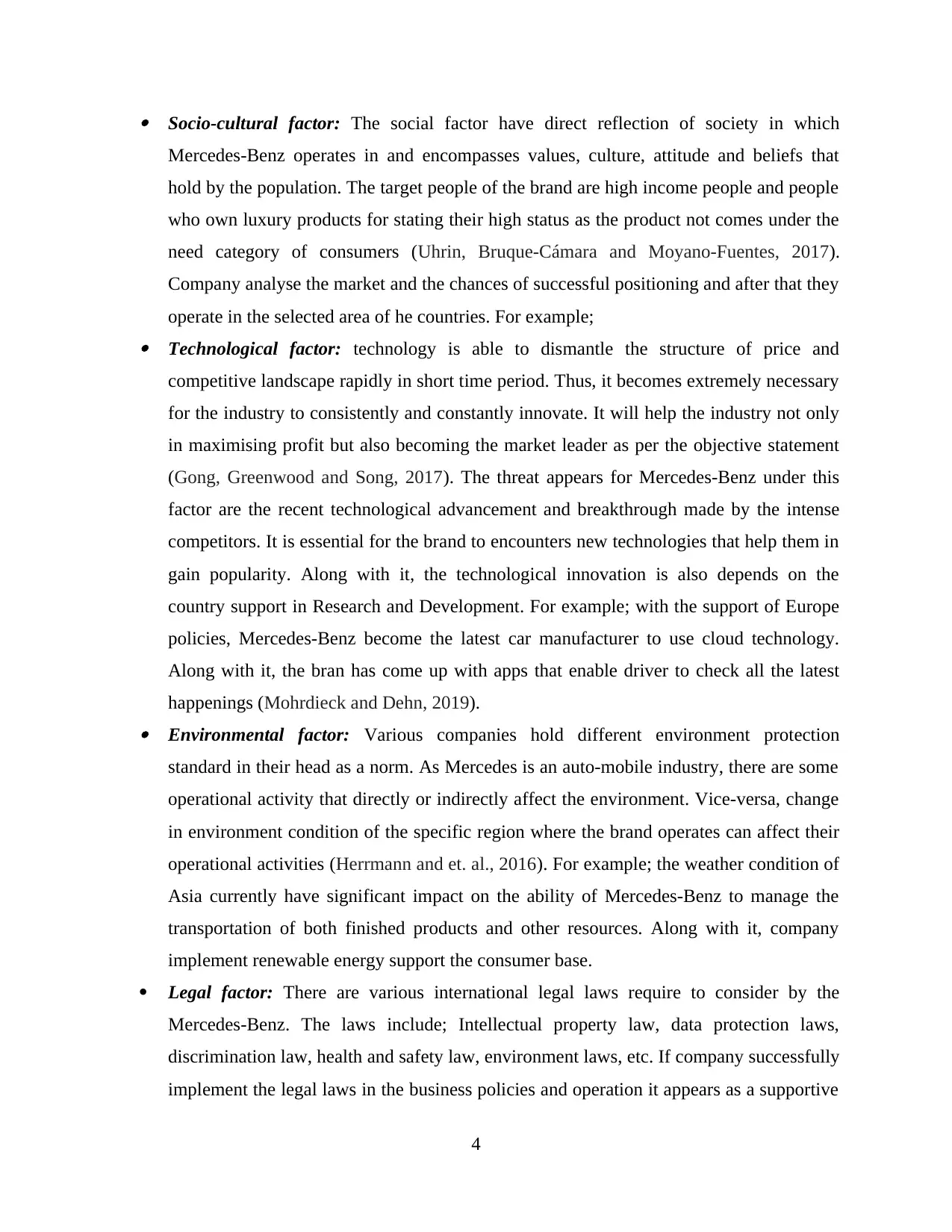
Socio-cultural factor: The social factor have direct reflection of society in which
Mercedes-Benz operates in and encompasses values, culture, attitude and beliefs that
hold by the population. The target people of the brand are high income people and people
who own luxury products for stating their high status as the product not comes under the
need category of consumers (Uhrin, Bruque-Cámara and Moyano-Fuentes, 2017).
Company analyse the market and the chances of successful positioning and after that they
operate in the selected area of he countries. For example; Technological factor: technology is able to dismantle the structure of price and
competitive landscape rapidly in short time period. Thus, it becomes extremely necessary
for the industry to consistently and constantly innovate. It will help the industry not only
in maximising profit but also becoming the market leader as per the objective statement
(Gong, Greenwood and Song, 2017). The threat appears for Mercedes-Benz under this
factor are the recent technological advancement and breakthrough made by the intense
competitors. It is essential for the brand to encounters new technologies that help them in
gain popularity. Along with it, the technological innovation is also depends on the
country support in Research and Development. For example; with the support of Europe
policies, Mercedes-Benz become the latest car manufacturer to use cloud technology.
Along with it, the bran has come up with apps that enable driver to check all the latest
happenings (Mohrdieck and Dehn, 2019). Environmental factor: Various companies hold different environment protection
standard in their head as a norm. As Mercedes is an auto-mobile industry, there are some
operational activity that directly or indirectly affect the environment. Vice-versa, change
in environment condition of the specific region where the brand operates can affect their
operational activities (Herrmann and et. al., 2016). For example; the weather condition of
Asia currently have significant impact on the ability of Mercedes-Benz to manage the
transportation of both finished products and other resources. Along with it, company
implement renewable energy support the consumer base.
Legal factor: There are various international legal laws require to consider by the
Mercedes-Benz. The laws include; Intellectual property law, data protection laws,
discrimination law, health and safety law, environment laws, etc. If company successfully
implement the legal laws in the business policies and operation it appears as a supportive
4
Mercedes-Benz operates in and encompasses values, culture, attitude and beliefs that
hold by the population. The target people of the brand are high income people and people
who own luxury products for stating their high status as the product not comes under the
need category of consumers (Uhrin, Bruque-Cámara and Moyano-Fuentes, 2017).
Company analyse the market and the chances of successful positioning and after that they
operate in the selected area of he countries. For example; Technological factor: technology is able to dismantle the structure of price and
competitive landscape rapidly in short time period. Thus, it becomes extremely necessary
for the industry to consistently and constantly innovate. It will help the industry not only
in maximising profit but also becoming the market leader as per the objective statement
(Gong, Greenwood and Song, 2017). The threat appears for Mercedes-Benz under this
factor are the recent technological advancement and breakthrough made by the intense
competitors. It is essential for the brand to encounters new technologies that help them in
gain popularity. Along with it, the technological innovation is also depends on the
country support in Research and Development. For example; with the support of Europe
policies, Mercedes-Benz become the latest car manufacturer to use cloud technology.
Along with it, the bran has come up with apps that enable driver to check all the latest
happenings (Mohrdieck and Dehn, 2019). Environmental factor: Various companies hold different environment protection
standard in their head as a norm. As Mercedes is an auto-mobile industry, there are some
operational activity that directly or indirectly affect the environment. Vice-versa, change
in environment condition of the specific region where the brand operates can affect their
operational activities (Herrmann and et. al., 2016). For example; the weather condition of
Asia currently have significant impact on the ability of Mercedes-Benz to manage the
transportation of both finished products and other resources. Along with it, company
implement renewable energy support the consumer base.
Legal factor: There are various international legal laws require to consider by the
Mercedes-Benz. The laws include; Intellectual property law, data protection laws,
discrimination law, health and safety law, environment laws, etc. If company successfully
implement the legal laws in the business policies and operation it appears as a supportive
4
Paraphrase This Document
Need a fresh take? Get an instant paraphrase of this document with our AI Paraphraser
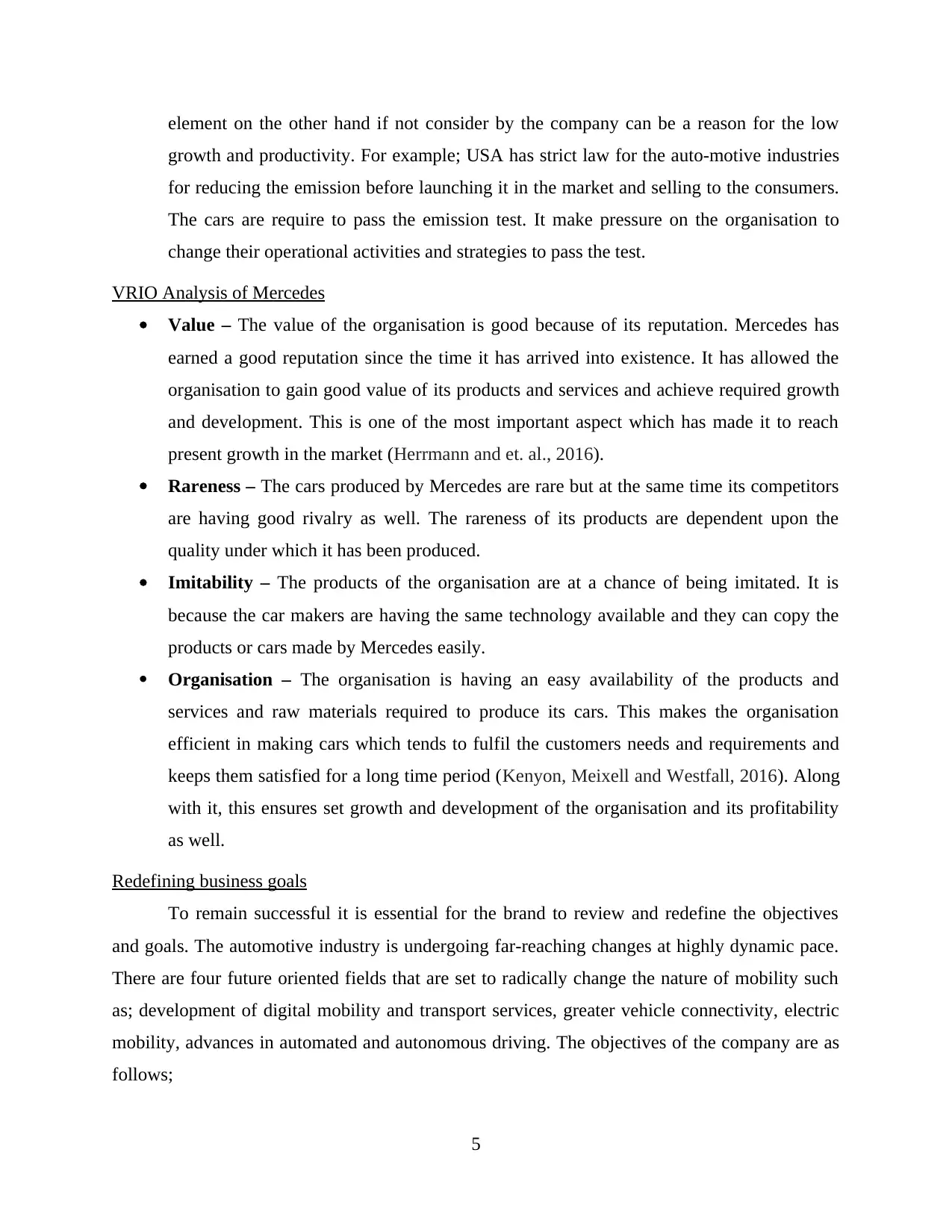
element on the other hand if not consider by the company can be a reason for the low
growth and productivity. For example; USA has strict law for the auto-motive industries
for reducing the emission before launching it in the market and selling to the consumers.
The cars are require to pass the emission test. It make pressure on the organisation to
change their operational activities and strategies to pass the test.
VRIO Analysis of Mercedes
Value – The value of the organisation is good because of its reputation. Mercedes has
earned a good reputation since the time it has arrived into existence. It has allowed the
organisation to gain good value of its products and services and achieve required growth
and development. This is one of the most important aspect which has made it to reach
present growth in the market (Herrmann and et. al., 2016).
Rareness – The cars produced by Mercedes are rare but at the same time its competitors
are having good rivalry as well. The rareness of its products are dependent upon the
quality under which it has been produced.
Imitability – The products of the organisation are at a chance of being imitated. It is
because the car makers are having the same technology available and they can copy the
products or cars made by Mercedes easily.
Organisation – The organisation is having an easy availability of the products and
services and raw materials required to produce its cars. This makes the organisation
efficient in making cars which tends to fulfil the customers needs and requirements and
keeps them satisfied for a long time period (Kenyon, Meixell and Westfall, 2016). Along
with it, this ensures set growth and development of the organisation and its profitability
as well.
Redefining business goals
To remain successful it is essential for the brand to review and redefine the objectives
and goals. The automotive industry is undergoing far-reaching changes at highly dynamic pace.
There are four future oriented fields that are set to radically change the nature of mobility such
as; development of digital mobility and transport services, greater vehicle connectivity, electric
mobility, advances in automated and autonomous driving. The objectives of the company are as
follows;
5
growth and productivity. For example; USA has strict law for the auto-motive industries
for reducing the emission before launching it in the market and selling to the consumers.
The cars are require to pass the emission test. It make pressure on the organisation to
change their operational activities and strategies to pass the test.
VRIO Analysis of Mercedes
Value – The value of the organisation is good because of its reputation. Mercedes has
earned a good reputation since the time it has arrived into existence. It has allowed the
organisation to gain good value of its products and services and achieve required growth
and development. This is one of the most important aspect which has made it to reach
present growth in the market (Herrmann and et. al., 2016).
Rareness – The cars produced by Mercedes are rare but at the same time its competitors
are having good rivalry as well. The rareness of its products are dependent upon the
quality under which it has been produced.
Imitability – The products of the organisation are at a chance of being imitated. It is
because the car makers are having the same technology available and they can copy the
products or cars made by Mercedes easily.
Organisation – The organisation is having an easy availability of the products and
services and raw materials required to produce its cars. This makes the organisation
efficient in making cars which tends to fulfil the customers needs and requirements and
keeps them satisfied for a long time period (Kenyon, Meixell and Westfall, 2016). Along
with it, this ensures set growth and development of the organisation and its profitability
as well.
Redefining business goals
To remain successful it is essential for the brand to review and redefine the objectives
and goals. The automotive industry is undergoing far-reaching changes at highly dynamic pace.
There are four future oriented fields that are set to radically change the nature of mobility such
as; development of digital mobility and transport services, greater vehicle connectivity, electric
mobility, advances in automated and autonomous driving. The objectives of the company are as
follows;
5
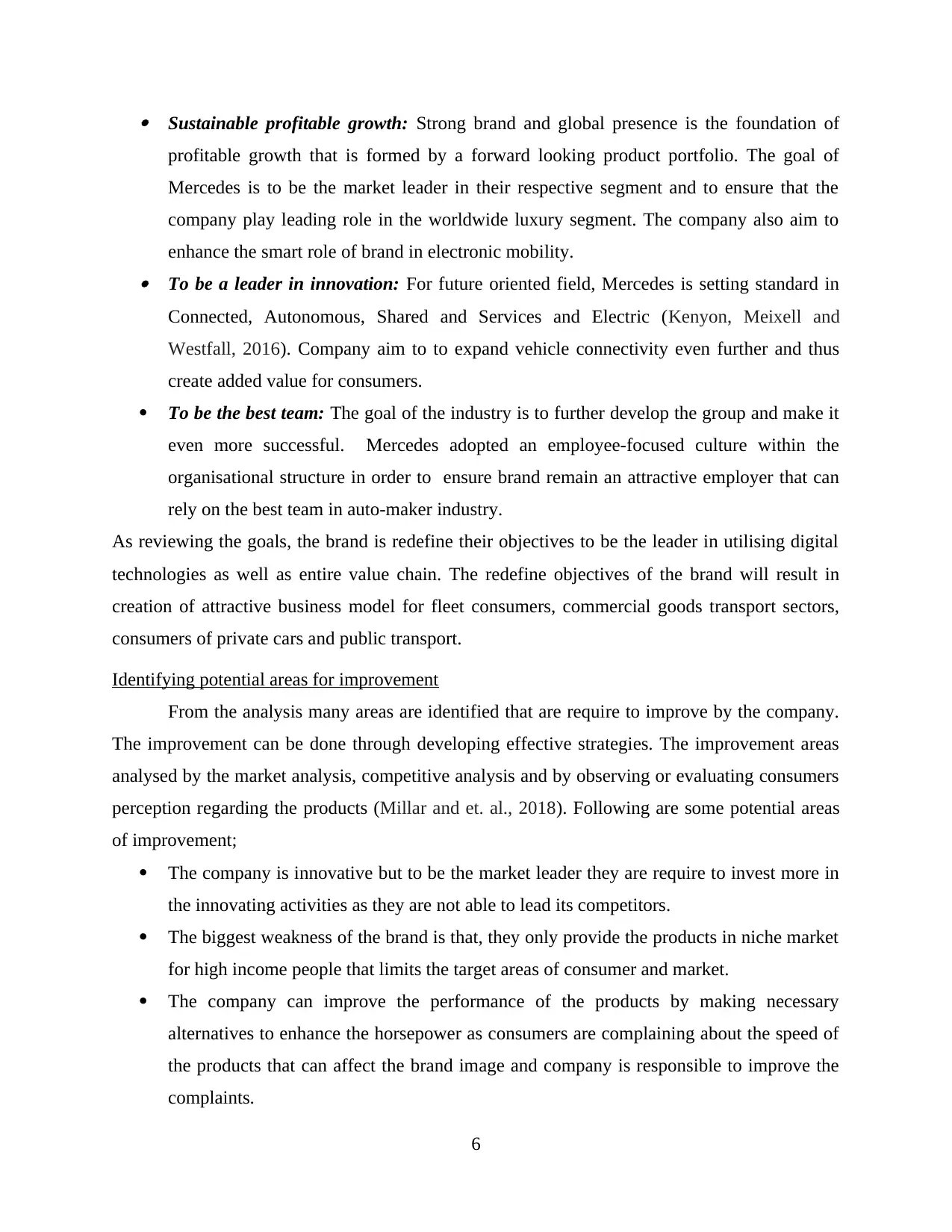
Sustainable profitable growth: Strong brand and global presence is the foundation of
profitable growth that is formed by a forward looking product portfolio. The goal of
Mercedes is to be the market leader in their respective segment and to ensure that the
company play leading role in the worldwide luxury segment. The company also aim to
enhance the smart role of brand in electronic mobility. To be a leader in innovation: For future oriented field, Mercedes is setting standard in
Connected, Autonomous, Shared and Services and Electric (Kenyon, Meixell and
Westfall, 2016). Company aim to to expand vehicle connectivity even further and thus
create added value for consumers.
To be the best team: The goal of the industry is to further develop the group and make it
even more successful. Mercedes adopted an employee-focused culture within the
organisational structure in order to ensure brand remain an attractive employer that can
rely on the best team in auto-maker industry.
As reviewing the goals, the brand is redefine their objectives to be the leader in utilising digital
technologies as well as entire value chain. The redefine objectives of the brand will result in
creation of attractive business model for fleet consumers, commercial goods transport sectors,
consumers of private cars and public transport.
Identifying potential areas for improvement
From the analysis many areas are identified that are require to improve by the company.
The improvement can be done through developing effective strategies. The improvement areas
analysed by the market analysis, competitive analysis and by observing or evaluating consumers
perception regarding the products (Millar and et. al., 2018). Following are some potential areas
of improvement;
The company is innovative but to be the market leader they are require to invest more in
the innovating activities as they are not able to lead its competitors.
The biggest weakness of the brand is that, they only provide the products in niche market
for high income people that limits the target areas of consumer and market.
The company can improve the performance of the products by making necessary
alternatives to enhance the horsepower as consumers are complaining about the speed of
the products that can affect the brand image and company is responsible to improve the
complaints.
6
profitable growth that is formed by a forward looking product portfolio. The goal of
Mercedes is to be the market leader in their respective segment and to ensure that the
company play leading role in the worldwide luxury segment. The company also aim to
enhance the smart role of brand in electronic mobility. To be a leader in innovation: For future oriented field, Mercedes is setting standard in
Connected, Autonomous, Shared and Services and Electric (Kenyon, Meixell and
Westfall, 2016). Company aim to to expand vehicle connectivity even further and thus
create added value for consumers.
To be the best team: The goal of the industry is to further develop the group and make it
even more successful. Mercedes adopted an employee-focused culture within the
organisational structure in order to ensure brand remain an attractive employer that can
rely on the best team in auto-maker industry.
As reviewing the goals, the brand is redefine their objectives to be the leader in utilising digital
technologies as well as entire value chain. The redefine objectives of the brand will result in
creation of attractive business model for fleet consumers, commercial goods transport sectors,
consumers of private cars and public transport.
Identifying potential areas for improvement
From the analysis many areas are identified that are require to improve by the company.
The improvement can be done through developing effective strategies. The improvement areas
analysed by the market analysis, competitive analysis and by observing or evaluating consumers
perception regarding the products (Millar and et. al., 2018). Following are some potential areas
of improvement;
The company is innovative but to be the market leader they are require to invest more in
the innovating activities as they are not able to lead its competitors.
The biggest weakness of the brand is that, they only provide the products in niche market
for high income people that limits the target areas of consumer and market.
The company can improve the performance of the products by making necessary
alternatives to enhance the horsepower as consumers are complaining about the speed of
the products that can affect the brand image and company is responsible to improve the
complaints.
6
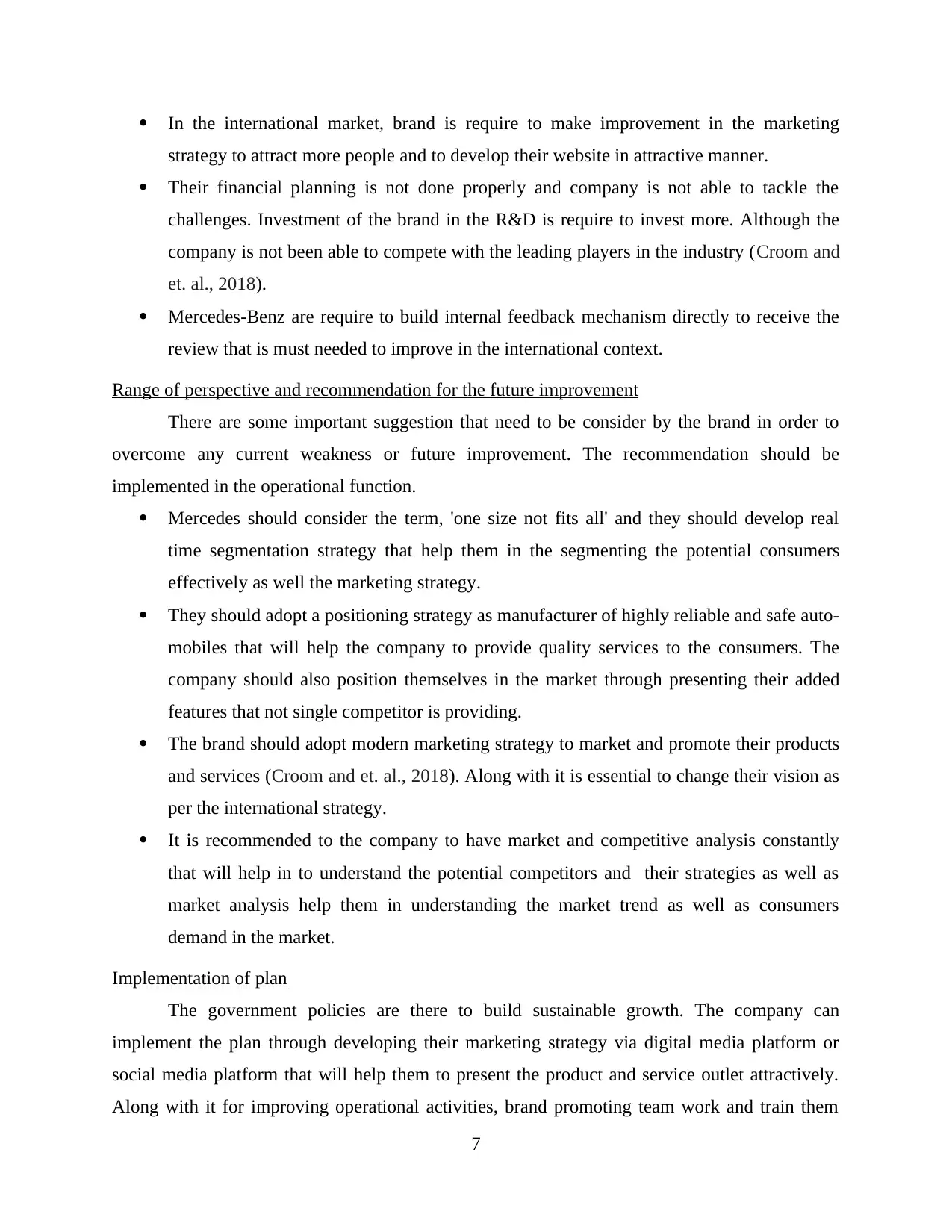
In the international market, brand is require to make improvement in the marketing
strategy to attract more people and to develop their website in attractive manner.
Their financial planning is not done properly and company is not able to tackle the
challenges. Investment of the brand in the R&D is require to invest more. Although the
company is not been able to compete with the leading players in the industry (Croom and
et. al., 2018).
Mercedes-Benz are require to build internal feedback mechanism directly to receive the
review that is must needed to improve in the international context.
Range of perspective and recommendation for the future improvement
There are some important suggestion that need to be consider by the brand in order to
overcome any current weakness or future improvement. The recommendation should be
implemented in the operational function.
Mercedes should consider the term, 'one size not fits all' and they should develop real
time segmentation strategy that help them in the segmenting the potential consumers
effectively as well the marketing strategy.
They should adopt a positioning strategy as manufacturer of highly reliable and safe auto-
mobiles that will help the company to provide quality services to the consumers. The
company should also position themselves in the market through presenting their added
features that not single competitor is providing.
The brand should adopt modern marketing strategy to market and promote their products
and services (Croom and et. al., 2018). Along with it is essential to change their vision as
per the international strategy.
It is recommended to the company to have market and competitive analysis constantly
that will help in to understand the potential competitors and their strategies as well as
market analysis help them in understanding the market trend as well as consumers
demand in the market.
Implementation of plan
The government policies are there to build sustainable growth. The company can
implement the plan through developing their marketing strategy via digital media platform or
social media platform that will help them to present the product and service outlet attractively.
Along with it for improving operational activities, brand promoting team work and train them
7
strategy to attract more people and to develop their website in attractive manner.
Their financial planning is not done properly and company is not able to tackle the
challenges. Investment of the brand in the R&D is require to invest more. Although the
company is not been able to compete with the leading players in the industry (Croom and
et. al., 2018).
Mercedes-Benz are require to build internal feedback mechanism directly to receive the
review that is must needed to improve in the international context.
Range of perspective and recommendation for the future improvement
There are some important suggestion that need to be consider by the brand in order to
overcome any current weakness or future improvement. The recommendation should be
implemented in the operational function.
Mercedes should consider the term, 'one size not fits all' and they should develop real
time segmentation strategy that help them in the segmenting the potential consumers
effectively as well the marketing strategy.
They should adopt a positioning strategy as manufacturer of highly reliable and safe auto-
mobiles that will help the company to provide quality services to the consumers. The
company should also position themselves in the market through presenting their added
features that not single competitor is providing.
The brand should adopt modern marketing strategy to market and promote their products
and services (Croom and et. al., 2018). Along with it is essential to change their vision as
per the international strategy.
It is recommended to the company to have market and competitive analysis constantly
that will help in to understand the potential competitors and their strategies as well as
market analysis help them in understanding the market trend as well as consumers
demand in the market.
Implementation of plan
The government policies are there to build sustainable growth. The company can
implement the plan through developing their marketing strategy via digital media platform or
social media platform that will help them to present the product and service outlet attractively.
Along with it for improving operational activities, brand promoting team work and train them
7
Secure Best Marks with AI Grader
Need help grading? Try our AI Grader for instant feedback on your assignments.
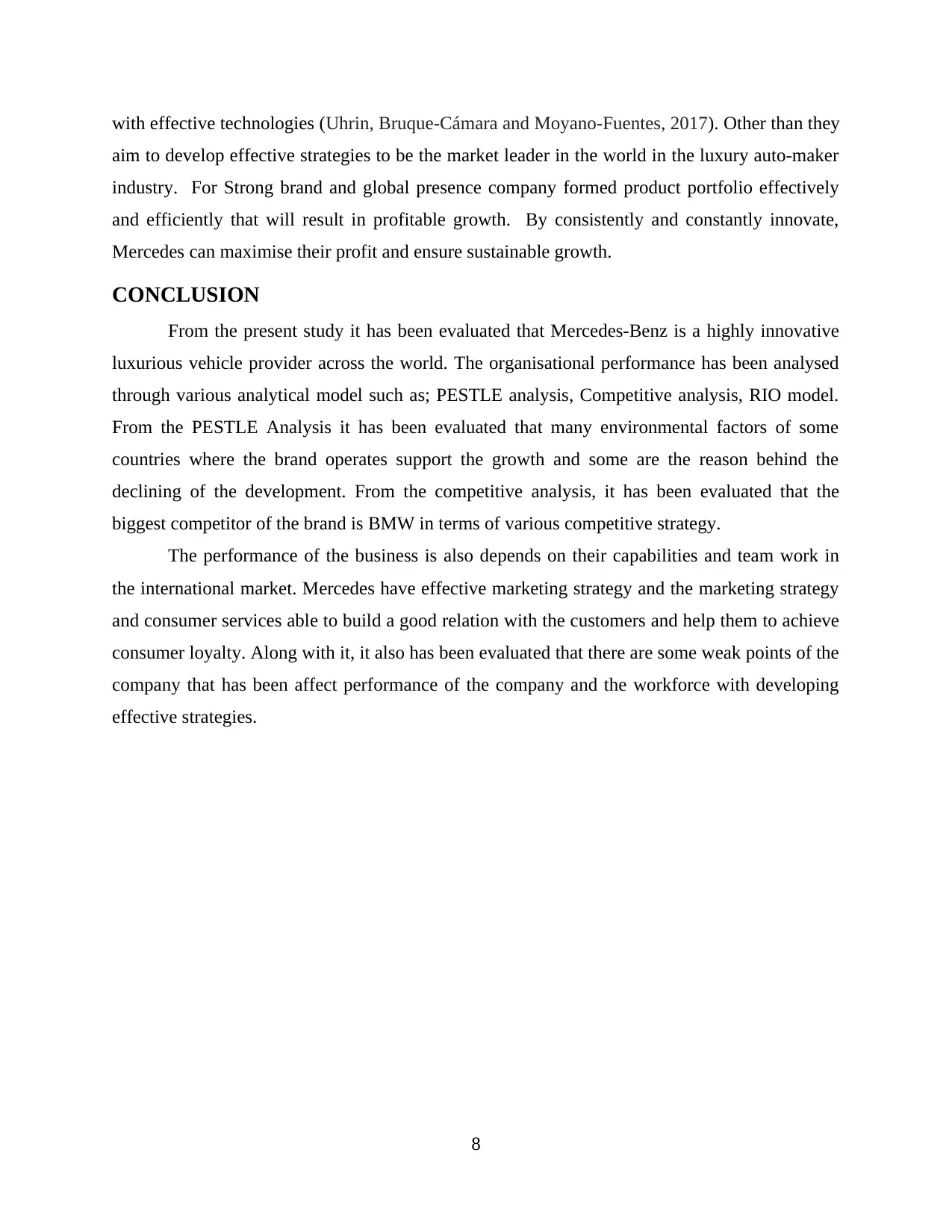
with effective technologies (Uhrin, Bruque-Cámara and Moyano-Fuentes, 2017). Other than they
aim to develop effective strategies to be the market leader in the world in the luxury auto-maker
industry. For Strong brand and global presence company formed product portfolio effectively
and efficiently that will result in profitable growth. By consistently and constantly innovate,
Mercedes can maximise their profit and ensure sustainable growth.
CONCLUSION
From the present study it has been evaluated that Mercedes-Benz is a highly innovative
luxurious vehicle provider across the world. The organisational performance has been analysed
through various analytical model such as; PESTLE analysis, Competitive analysis, RIO model.
From the PESTLE Analysis it has been evaluated that many environmental factors of some
countries where the brand operates support the growth and some are the reason behind the
declining of the development. From the competitive analysis, it has been evaluated that the
biggest competitor of the brand is BMW in terms of various competitive strategy.
The performance of the business is also depends on their capabilities and team work in
the international market. Mercedes have effective marketing strategy and the marketing strategy
and consumer services able to build a good relation with the customers and help them to achieve
consumer loyalty. Along with it, it also has been evaluated that there are some weak points of the
company that has been affect performance of the company and the workforce with developing
effective strategies.
8
aim to develop effective strategies to be the market leader in the world in the luxury auto-maker
industry. For Strong brand and global presence company formed product portfolio effectively
and efficiently that will result in profitable growth. By consistently and constantly innovate,
Mercedes can maximise their profit and ensure sustainable growth.
CONCLUSION
From the present study it has been evaluated that Mercedes-Benz is a highly innovative
luxurious vehicle provider across the world. The organisational performance has been analysed
through various analytical model such as; PESTLE analysis, Competitive analysis, RIO model.
From the PESTLE Analysis it has been evaluated that many environmental factors of some
countries where the brand operates support the growth and some are the reason behind the
declining of the development. From the competitive analysis, it has been evaluated that the
biggest competitor of the brand is BMW in terms of various competitive strategy.
The performance of the business is also depends on their capabilities and team work in
the international market. Mercedes have effective marketing strategy and the marketing strategy
and consumer services able to build a good relation with the customers and help them to achieve
consumer loyalty. Along with it, it also has been evaluated that there are some weak points of the
company that has been affect performance of the company and the workforce with developing
effective strategies.
8
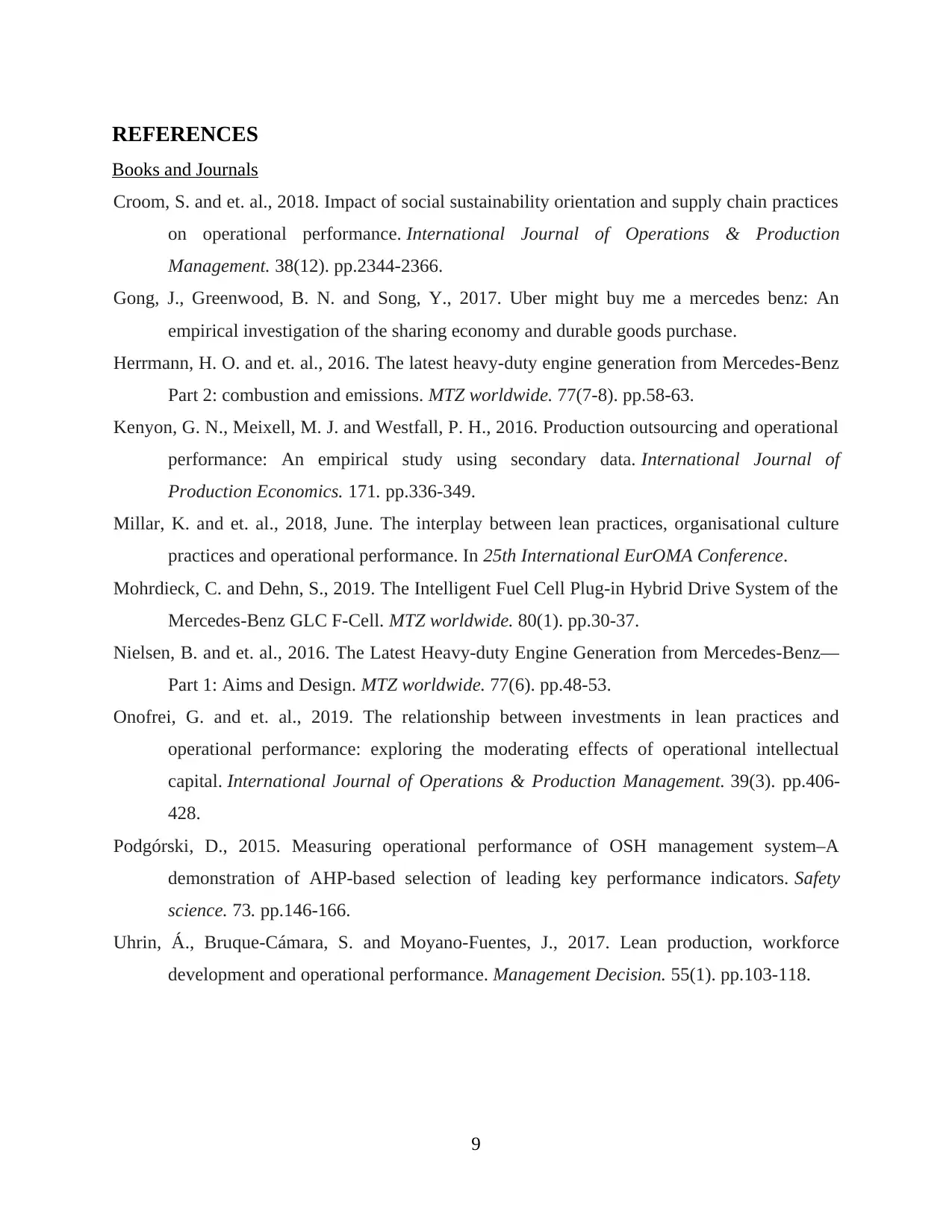
REFERENCES
Books and Journals
Croom, S. and et. al., 2018. Impact of social sustainability orientation and supply chain practices
on operational performance. International Journal of Operations & Production
Management. 38(12). pp.2344-2366.
Gong, J., Greenwood, B. N. and Song, Y., 2017. Uber might buy me a mercedes benz: An
empirical investigation of the sharing economy and durable goods purchase.
Herrmann, H. O. and et. al., 2016. The latest heavy-duty engine generation from Mercedes-Benz
Part 2: combustion and emissions. MTZ worldwide. 77(7-8). pp.58-63.
Kenyon, G. N., Meixell, M. J. and Westfall, P. H., 2016. Production outsourcing and operational
performance: An empirical study using secondary data. International Journal of
Production Economics. 171. pp.336-349.
Millar, K. and et. al., 2018, June. The interplay between lean practices, organisational culture
practices and operational performance. In 25th International EurOMA Conference.
Mohrdieck, C. and Dehn, S., 2019. The Intelligent Fuel Cell Plug-in Hybrid Drive System of the
Mercedes-Benz GLC F-Cell. MTZ worldwide. 80(1). pp.30-37.
Nielsen, B. and et. al., 2016. The Latest Heavy-duty Engine Generation from Mercedes-Benz—
Part 1: Aims and Design. MTZ worldwide. 77(6). pp.48-53.
Onofrei, G. and et. al., 2019. The relationship between investments in lean practices and
operational performance: exploring the moderating effects of operational intellectual
capital. International Journal of Operations & Production Management. 39(3). pp.406-
428.
Podgórski, D., 2015. Measuring operational performance of OSH management system–A
demonstration of AHP-based selection of leading key performance indicators. Safety
science. 73. pp.146-166.
Uhrin, Á., Bruque-Cámara, S. and Moyano-Fuentes, J., 2017. Lean production, workforce
development and operational performance. Management Decision. 55(1). pp.103-118.
9
Books and Journals
Croom, S. and et. al., 2018. Impact of social sustainability orientation and supply chain practices
on operational performance. International Journal of Operations & Production
Management. 38(12). pp.2344-2366.
Gong, J., Greenwood, B. N. and Song, Y., 2017. Uber might buy me a mercedes benz: An
empirical investigation of the sharing economy and durable goods purchase.
Herrmann, H. O. and et. al., 2016. The latest heavy-duty engine generation from Mercedes-Benz
Part 2: combustion and emissions. MTZ worldwide. 77(7-8). pp.58-63.
Kenyon, G. N., Meixell, M. J. and Westfall, P. H., 2016. Production outsourcing and operational
performance: An empirical study using secondary data. International Journal of
Production Economics. 171. pp.336-349.
Millar, K. and et. al., 2018, June. The interplay between lean practices, organisational culture
practices and operational performance. In 25th International EurOMA Conference.
Mohrdieck, C. and Dehn, S., 2019. The Intelligent Fuel Cell Plug-in Hybrid Drive System of the
Mercedes-Benz GLC F-Cell. MTZ worldwide. 80(1). pp.30-37.
Nielsen, B. and et. al., 2016. The Latest Heavy-duty Engine Generation from Mercedes-Benz—
Part 1: Aims and Design. MTZ worldwide. 77(6). pp.48-53.
Onofrei, G. and et. al., 2019. The relationship between investments in lean practices and
operational performance: exploring the moderating effects of operational intellectual
capital. International Journal of Operations & Production Management. 39(3). pp.406-
428.
Podgórski, D., 2015. Measuring operational performance of OSH management system–A
demonstration of AHP-based selection of leading key performance indicators. Safety
science. 73. pp.146-166.
Uhrin, Á., Bruque-Cámara, S. and Moyano-Fuentes, J., 2017. Lean production, workforce
development and operational performance. Management Decision. 55(1). pp.103-118.
9
1 out of 12
Related Documents
Your All-in-One AI-Powered Toolkit for Academic Success.
+13062052269
info@desklib.com
Available 24*7 on WhatsApp / Email
![[object Object]](/_next/static/media/star-bottom.7253800d.svg)
Unlock your academic potential
© 2024 | Zucol Services PVT LTD | All rights reserved.





